Every August, Japan is filled with the warm glow of lanterns, the rhythm of drums, and the graceful movements of traditional dance. This is Obon (お盆)—one of Japan’s most important summer traditions. More than just a festival, Obon is a time for families to welcome the spirits of their ancestors back home and honor their memory.
What is Obon?

Obon is a Buddhist-inspired event observed throughout Japan, typically in mid-August (though some regions celebrate in July). It is believed that during Obon, the spirits of ancestors return to visit their families.
To welcome them, families:
- Clean the household altar (butsudan) and offer food, flowers, and incense
- Place lanterns (chochin) outside the home to guide spirits
- Visit gravesites to pay respects (ohaka-mairi)
At the end of Obon, lanterns are floated down rivers or set out to sea in a moving ceremony called tōrō nagashi (灯籠流し), symbolically sending the spirits back to the other world.
The Spirit of Light and Connection
Lanterns are a powerful symbol of Obon. They are said to light the path for spirits—welcoming them home and guiding them safely back.
This imagery beautifully reflects the Japanese sensitivity to nature, family, and impermanence. Just like a softly glowing lantern in the night, Obon reminds us that while life is fleeting, memories and connections remain bright across generations.
Seirei-ba (精霊馬) – Spirit Animals of Obon

Another charming and symbolic tradition of Obon is creating Seirei-ba, small figures made from cucumbers and eggplants with wooden sticks for legs. You might have seen them in the anime movie “Your Name” in 2016. The cucumber represents a horse, while the eggplant represents a cow. Families place these spirit animals on their household altar to welcome and send off ancestors.
The meanings are deeply symbolic:
- Cucumber horse (kyūri no uma / きゅうりの馬) → so that the spirits can ride swiftly back home at the start of Obon.
- Eggplant cow (nasu no ushi / なすの牛) → so the spirits can return slowly and peacefully, carrying the blessings and offerings from their families.
This tender custom shows the Japanese care for ensuring ancestors’ comfort during their journey between worlds. Even today, many families enjoy making Seirei-ba with children, keeping the tradition alive in a heartfelt way.
Nii-bon (新盆 / 初盆) – The First Obon
A very special observance during Obon is called Nii-bon or Hatsu-bon. This refers to the first Obon following the passing of a loved one.
For many families, Nii-bon is a deeply emotional time because it marks the first return of the spirit to their home. It is often observed with:
- Extra offerings of food, flowers, and incense
- Pure white lanterns (shōryō-dōrō) to guide the spirit home
- Special memorial services held at temples
- Visits and gatherings of extended family and close friends
Because of its importance, Nii-bon tends to be larger and more formal than regular Obon celebrations, with families often preparing more carefully to honor the memory of the deceased.
Nii-bon reflects the Japanese value of continuity and remembrance, ensuring that even in grief, families find ways to stay connected with loved ones across generations.
Bon Odori – Dance of Joy

One of the highlights of Obon is Bon Odori (盆踊り), traditional communal dancing. Villagers and city-dwellers alike gather in yukata (light summer kimono) to dance around a raised platform (yagura), accompanied by drums and folk songs.
Each region has its own unique Bon Odori style—some slow and graceful, others lively and energetic. The dance is not just performance; it’s a way of connecting with ancestors and community through movement and rhythm.
Obon as a Family Reunion

Obon is often compared to Christmas or Thanksgiving in Western culture because it brings families together. Many people travel back to their hometowns during Obon, leading to packed trains and highways known as the Obon rush.
It is a time to:
- Reconnect with relatives
- Share seasonal foods like watermelon and somen noodles
- Reflect on family history and stories
Experience Obon, Wherever You Are
Even if you are outside Japan, you can embrace the Obon spirit by:
- Lighting a lantern in memory of loved ones
- Attending a Bon Odori festival (many Japanese communities worldwide host them)
- Cooking simple Japanese summer foods like somen noodles
- Wearing a yukata or adding a Japanese-inspired accessory to your summer outfit
Final Thought
Obon is a reminder that tradition is living, breathing, and shared. It’s not just about looking back—it’s about carrying those connections forward into the future. At Tokita Kobo, we celebrate this same spirit through each piece we create, keeping memories alive through fabric, form, and storytelling.

